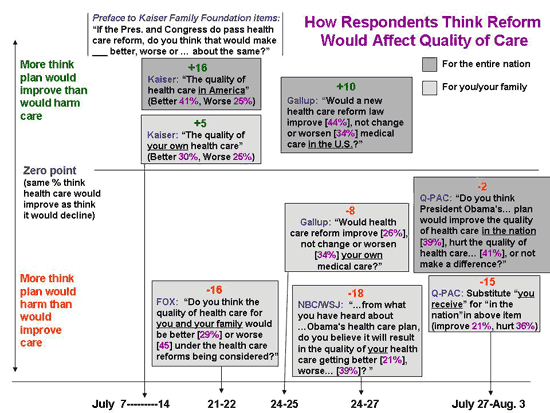How do Americans think health care reform will affect the quality of health care? Pollsters have addressed this question from two frames of reference, how people think health care will be affected for the nation as a whole, and for oneself and one’s family. As shown in the diagram below (which you can click to enlarge), the polling is clear. Americans appear far more sanguine that reform will improve health care at the national level (darker-shaded boxes) than in their own personal lives (lighter-shaded boxes). Regarding anticipated impact on health care for the nation at large, two recent polls (Kaiser and Gallup) show sizable pluralities in a positive direction — in other words, more people think health care nationally will be improved than degraded. A third recent poll, Quinnipiac, has it essentially even. (A Rasmussen poll from back in January produced more pessimistic results.)
When it comes to perceived personal impact, however, there’s near-unanimity in the polls that reform will damage the care individuals and their families receive (the one exception is the poll by Kaiser, where a slight plurality thinks its own care will get better).
The above pattern — where Americans have responded relatively favorably regarding how they think reform will affect health care nationally — may be a good sign for President Obama and the Democrats as they seek to enact (and potentially at a later time, implement) health care reform legislation.
While I was studying for my Ph.D. in social psychology at the University of Michigan in the 1980s, I took a course on public opinion from political scientist/social psychologist Donald Kinder. One of Prof. Kinder’s ideas at the time, as I understood it, was that support for an incumbent president is driven more by individual voters’ collective (“we”) perception of how well the economy is doing for the nation as a whole, than by an individualistic (“me”) perception of how that particular voter is doing. I just found an online document that summarizes this research more formally:
Early studies assumed [support for an incumbent president] was indicative of pocketbook voting −- citizens rewarding and punishing incumbents based on their own economic circumstances (Key 1968; Kramer 1971). But subsequent studies established that the effect of personal economic circumstances was small in magnitude relative to perceptions of the state of the national economy (Kinder and Kiewiet 1979; Markus 1988, 1992). This phenomena of evaluating the president based on national rather than personal economic circumstances, known as “sociotropic” voting, has become one of the main ways in the political science literature that voters systematically hold presidents accountable for their performance in office (Fiorina 1981; Achen and Bartels 2004).
A couple of cautionary notes are in order before folks at the White House begin popping the champagne corks. First, will the sociotropism phenomenon hold as well for health care as for the state of the economy (especially given the current recession/depression)? Second, the above poltical-science excerpt makes clear that it’s actual — not merely anticipated — results that voters are looking at. On the whole, though, these poll findings would seem to provide reasonably good news for the Democrats.
- Bulenox: Get 45% to 91% OFF ... Use Discount Code: UNO
- Risk Our Money Not Yours | Get 50% to 90% OFF ... Use Discount Code: MMBVBKSM
Disclaimer: This page contains affiliate links. If you choose to make a purchase after clicking a link, we may receive a commission at no additional cost to you. Thank you for your support!



Good News !
A staff writer at The New Yorker and some experts have examined Medicare data from the successful hospitals of 10 regions, and they have found evidence that more effective, lower-cost care is possible.
Please be ‘sure’ to visit http://www.nytimes.com/2009/08/13/opinion/13gawande.html?hp for credible evidence !
Some have followed the Mayo model with salaried doctors employed, Other regions, too, have found ways to protect patients against the pursuit of revenues over patient.
And a cardiac surgeon of them said they had adopted electronic systems, examined the data and found that a shocking portion of them were almost certainly unnecessary, possibly harmful.
According to analysis, their quality scores are well above average. Yet they spend more than $1,500 (16 percent) less per Medicare patient than the national average and have a slower real annual growth rate (3 percent versus 3.5 percent nationwide).
Surprisingly, 16 % of about $550 billion (the total of medicare cost per year) is around $88 billion per year, except for Medicaid (total cost of around $500 billion per year), medicare ‘alone’ can save $880 billion over the next decade.
In addition, under the reform package, along with the already allocated $583 billion, the wastes involving so called “doughnut hole” , the unnecessary subsidies for insurers, abuse, exorbitant costs by the tragic ER visits etc are weeded out, the concern over revenue might be a thing of the past.
(( Net Medicare and Medicaid savings of $465 billion + the $583 billion revenue package = $1048 billion – the previously estimated $1.042 trillion cost of reform = $6 billion surplus – $245 billion (the 10-year cost of adjusting Medicare reimbursement rates so physicians don’t face big annual pay cuts) = the estimated deficit of $239 billion ))
In modernized society, the business lacking IT system is unthinkable just like pre-electricity period, nevertheless, the last thing to expect is happening now in the sector requiring the best accuracy in respect to dealing with human lives. Apparently the errors by no e-medical records have spawned the crushing lawsuits (Medical malpractice lawsuits cost at least $150 billion per year), and these costs have led to the unnecessary tests, treatments, even more profits so far. And in different parts of the U.S., patients get two to three times as much care for the same disease, with the same result.
Thank You !